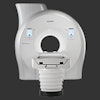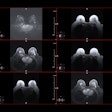
Insurance coverage for prostate MRI scans varies widely among private payors, requires certain conditions for reimbursement of major conditions, and does not reflect current clinical practice. Those harsh conclusions are contained in a new study published online September 11 in the Journal of the American College of Radiology.
When researchers analyzed the policies of 81 payors, they found that only two specifically covered prostate MRI for active surveillance without a repeat biopsy.
"This conflicts with current guidelines, which recognize the ability of prostate MRI to evaluate disease progression noninvasively," wrote the group led by Dr. Michael Booker from the University of California, San Diego.
MRI is being used more often to diagnose prostate issues; however, there is concern that insurance coverage might not have kept pace, the authors wrote. They described the market as "highly variable, with multiple private payors, radiology benefit managers, and associated government policies all creating unique requirements."
In addition, the U.S. Centers for Medicare and Medicaid Services (CMS) has yet to issue a national coverage determination for prostate MRI, and "there is little guidance from CMS discussing the examination's medical necessity," Booker and colleagues added.
To explore the situation, the researchers searched the Policy Reporter database for information on the current procedural terminology (CPT) codes related to pelvic MRI. The 81 plans in the study cover some 149 million people for scenarios that include initial diagnosis, staging, active surveillance, and suspected recurrence.
Nine payors (11%) cover MRI scans for patients with suspected prostate cancer, the researchers found, but there are conditions: a prostate-specific antigen (PSA) threshold of 3.5 ng/mL or an abnormal digital rectal examination. The other 72 insurers (89%) require a previous negative biopsy, as well as increasing PSA levels or an abnormal exam.
They also found that 70 payors (86%) cover initial staging, but again there are caveats. Most have criteria such as PSA levels of at least 20 ng/mL, a Gleason score of 7 or 8, a tumor stage of T3 or T4, or a 20% or greater risk of nodal metastases.
What's more, only 10 payors (12%) address active surveillance, with eight of them requiring a repeat biopsy before reimbursing for prostate MRI. Even then, a follow-up MRI to look for possible post-treatment cancer recurrence often requires rising PSA levels or an abnormal digital rectal exam. In addition, only 10 insurers (10%) have coverage after androgen deprivation treatment.
The situation for high-risk patients is not ideal, the authors noted. Payor requirements often conflict with the current American Urological Association recommendation of 10% nomogram thresholds. The insurers' higher threshold disregards the contributions of prostate MRI in choosing the most appropriate therapy for patients with low or intermediate risk of disease.
"It is therefore important for radiology groups to understand the particularities of their regional payor mix and continue to work locally to help update guidelines. ... Regardless of the path forward, it will be important for radiologists, urologists, patients, and their stakeholders to continue to advocate for coverage of prostate MRI given its clinical efficacy and added value to patient care," Booker and colleagues wrote.



















